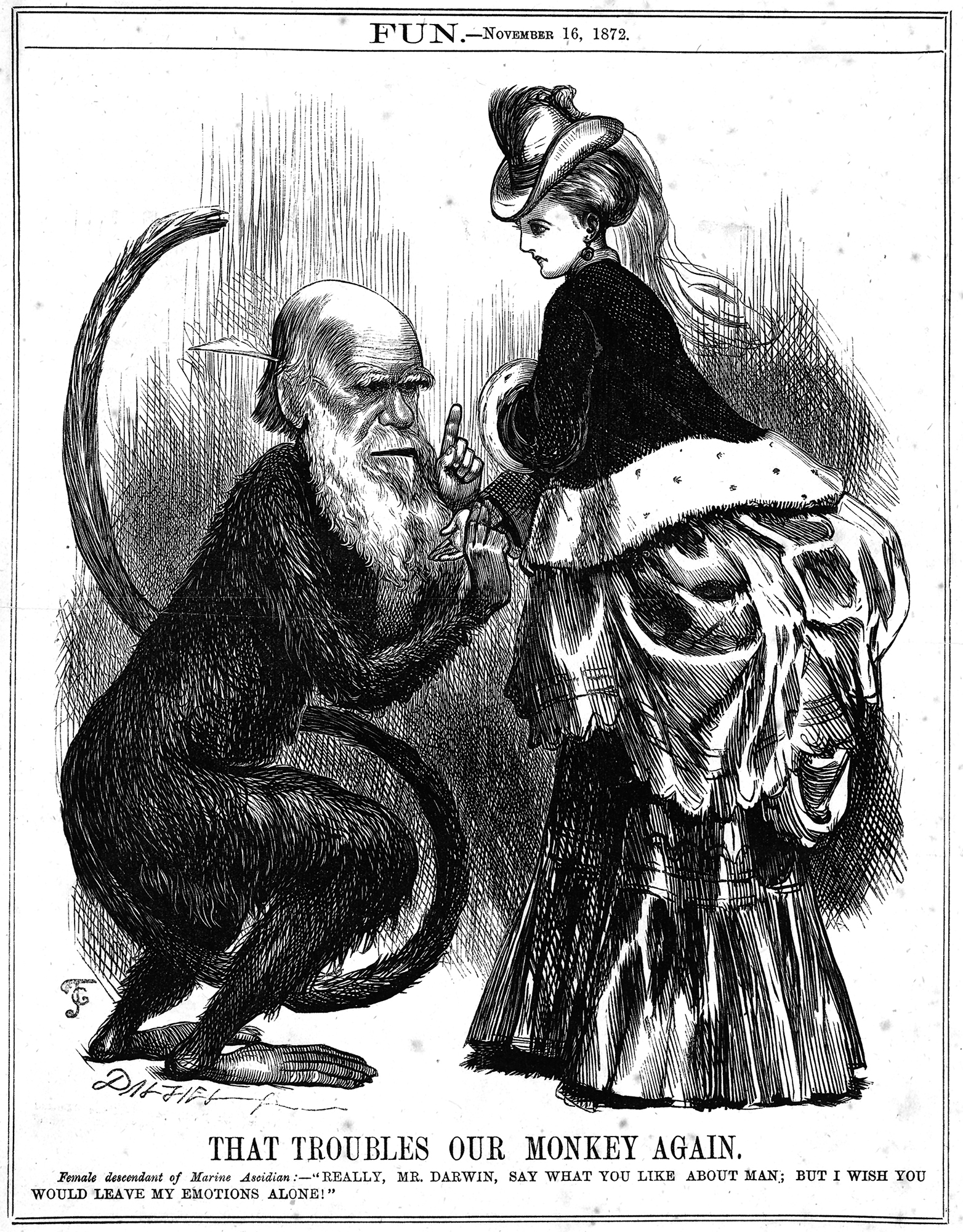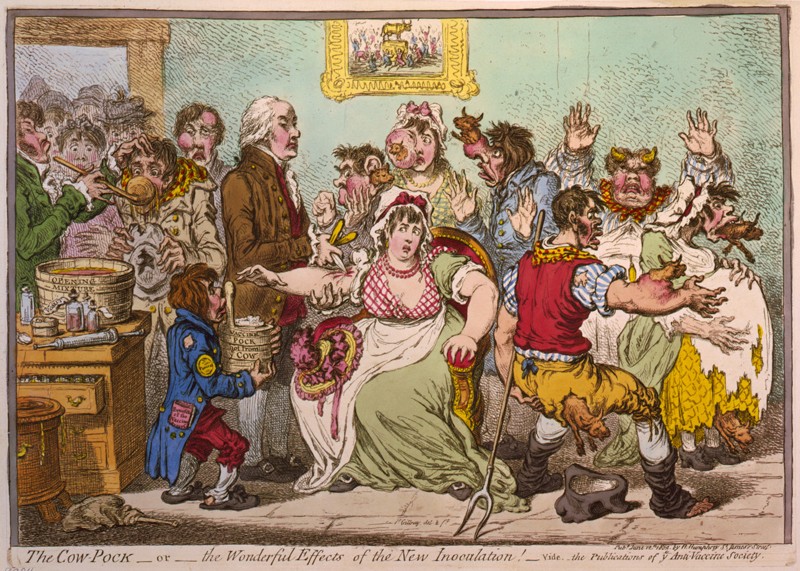"Leave my emotions alone"
« previous post | next post »
I've been going through old boxes of paper, looking for (the very small fraction of) stuff that I want to keep, and recycling the rest. I'm uncovering many interesting memories, as well as a few things that I have no recollection of at all. Representing the latter category is a faded xerox of the cartoon reproduced below. From the surrounding strata, my copy can be dated to 1988.
I learned more about this image's content and context from a bit of online search. Thus Janet Browne ("Darwin in caricature: A study in the popularisation and dissemination of evolution", Proceedings of the American Philosophical Society, 2001) explains that
Darwin's general hairiness could easily be turned into the animal fur of anthropoid apes. Add a tail, and there was an image immediately conveying the idea of human evolution. The Hornet displayed Darwin as a "Venerable Orang-Outang: A contribution to Unnatural History" in March 1871. The Dalziel brothers, the most eminent team of British wood-engravers of the period, produced the same set of symbolic devices in "That Troubles our Monkey again" for Fun in 1872. The Dalzeils add a well-bred young woman to accentuate what was to them the shocking idea of apish relatives in the family tree. These pictures of Darwin-as-ape or Darwin-as-monkey readily identified him as the author of the theory, in much the same way as a tricorne hat signalled Napoleon.
And Alexandra Witze ("Q&A: How cartoonists skewer tensions between science and society", Nature 2/1/2021) points out a connection between the woman's skirts and marine ascidians, which I totally missed:
Another of my favourites is an 1872 cartoon of Charles Darwin as a monkey squatting suggestively close to a woman whose billowing skirts resemble a sea squirt. Victorians found this one funny without needing any explanation. In his latest book, Darwin had dared to compare human with animal emotions — and he also relied on his argument that women’s evolutionary history made them more proficient in the kitchen than in the study. That the caption includes the technical name for sea squirt, ‘ascidian’, testifies to the enormous contemporary enthusiasm for exploring marine life and rocks along the coast.
(In fact, I carelessly misread the caption as referring to some then-well-known woman named something like Ma?ine A?idian…)
One remaining question for me is how to parse (and interpret) the cartoon's caption, "That troubles our monkey again." Is that the demonstrative or the complementizer? And in either case, what's the reference of the subject of troubles, and when did it trouble our monkey before?
Witze's article leads off with this great visual parody of vaccine skepticism as of 1802:
As Wikipedia explains,
Produced after Edward Jenner administered the first vaccine, Gillray’s work caricatured the fear patients had being vaccinated from smallpox via cowpox that it would make them sprout cowlike appendages.
Plus ça change…
Some past LLOG posts vaguely related to Darwin, emotion, and speech:
"Darwin and Deacon on love and language", 2/14/2004
"Aw+", 4/29/2004
"Poem in the key of what", 10/9/2006
"Political correctness, biology and culture", 10/31/2006
"The cabinet of Dr. Birdwhistell", 11/2/2006
"Musical protolanguage: Darwin's theory of language evolution revisited", 2/12/2009
"An inquiry concerning the principles of morals", 4/7/2009
I thought I once posted about Darwin's attempts to find small-integer musical intervals in animal vocalizations, but apparently I planned such a post and never got around to it.


Scott Underwood said,
July 5, 2021 @ 1:54 pm
There are two features in the image that should be mentioned for interpretation: one is that the Darwin figure appears to be taking the pulse of the young woman, and the other is that in 1872, Darwin published "The Expression of the Emotions in Man and Animals," which posits another close (and controversial) connection between humans and other creatures: that we all feel and display emotions similarly. The woman seems to refer to this book.
An excerpt from this book: "We will now turn to the characteristic symptoms of Rage. Under this powerful emotion the action of the heart is much accelerated,9 or it may be much disturbed." Footnote 9: "I am much indebted to Mr. A. H. Garrod for having informed me of M. Lorain's work on the pulse, in which a sphygmogram of a woman in a rage is given; and this shows much difference in the rate and other characters from that of the same woman in her ordinary state."
I don't know if this idea made it into popular culture, but that's my guess.
[(myl) Good point about the pulse-taking. But I took it for granted that readers would know about The Expression of the Emotions in Man and Animals, which is referenced in a couple of the cited posts.]
female descendent of a marine ascidian said,
July 5, 2021 @ 3:51 pm
Many people do believe that all vertebrates arose from creatures that resembled a marine ascidian. The larvae have a long muscular tail, a notochord, a dorsal neural tube (precursor of the spinal cord), and other features that fit. If that is true then all of us could be described as "descendants of a marine ascidian." But, did people know that in 1872?
Ed M said,
July 5, 2021 @ 4:02 pm
I read the caption as "That Troubles the monkey, again", and assumed that Troubles was the name of the cartoon ape/Darwin.
Orangutans ("Apparently < Malay orang utan person of the forest" according to OED) are considered apes, not monkeys, but I believe in the 1870s "monkey" and "ape" were used interchangeably.
David L said,
July 5, 2021 @ 4:06 pm
Just to be clear, the Nature article is an interview by Alexandra Witze of Patricia Fara, a science historian, and the explanations of the cartoons are Fara's.
Seth said,
July 5, 2021 @ 11:26 pm
I read this cartoon as:
That = An issue
Troubles = (verb)
Our Monkey = Darwin (monkey = the silly person who think humans are monkeys)
Again = Another problem with Darwin's theory of evolution.
Then the dialogue:
Female descendent of Marine Ascidian = Mocking reference to evolution theory paraphrase of "man descended from apes"
Then using the woman to emphasize "emotions".
I view the whole cartoon as mocking evolution from what would be the equivalent of a modern pundit hot-take. It's basically saying "Here's another weirdness from that crazy monkey-man Darwin('s theory of evolution), he's claiming that animals have emotions just like humans".
D.O. said,
July 6, 2021 @ 6:54 pm
I have a slightly different interpretatio than Seth: That (sex) troubles (interests) our monkey (Darwin) again (previous time it was The Descent of Man, and Selection in Relation to Sex)
Rick Rubenstein said,
July 8, 2021 @ 12:23 am
I'm pretty sure ape-Darwin is peeved because the young lady has just used "that" to introduce a restrictive clause. Quotation marks in the caption would of course have made this clearer.